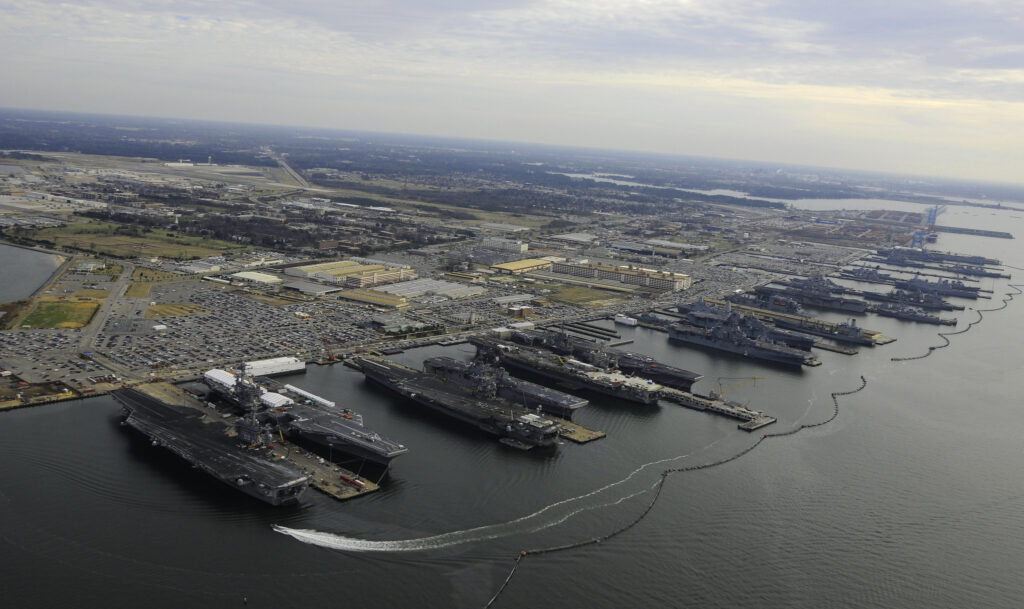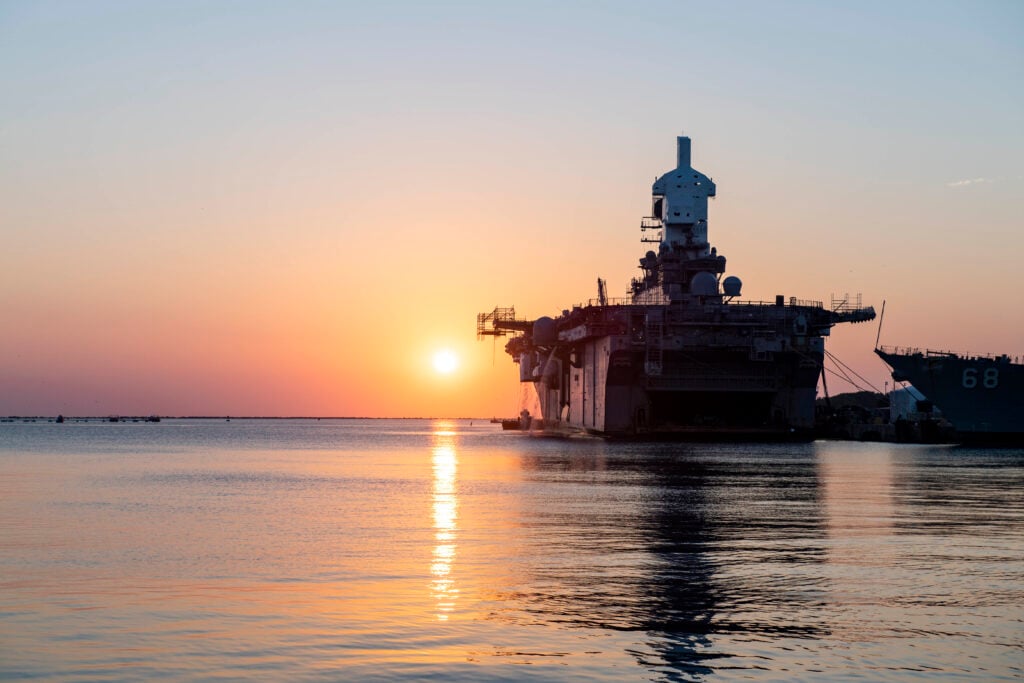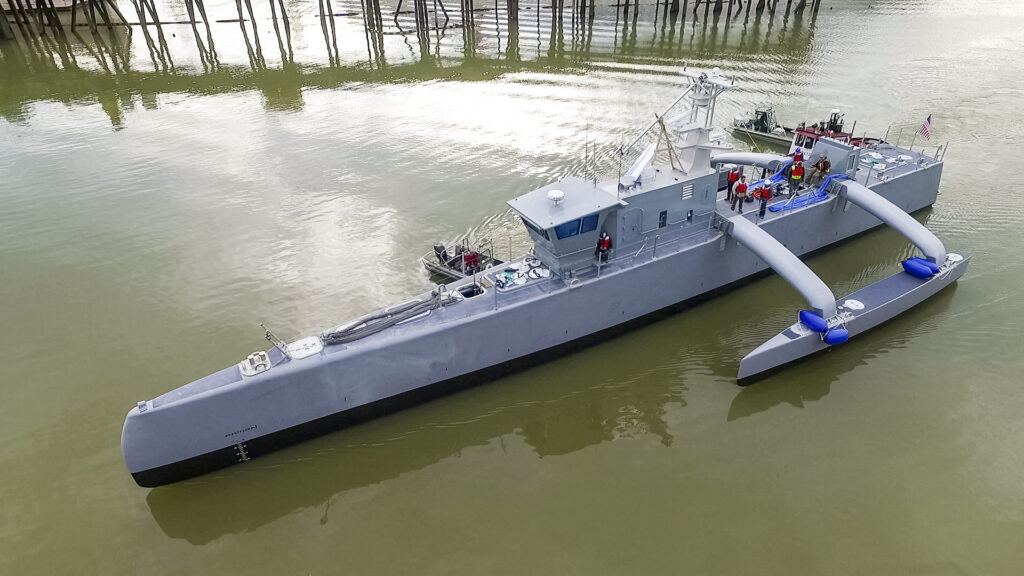
USS Dwight D. Eisenhower, USS George H.W. Bush, USS Enterprise, USS Harry S. Truman and USS Abraham Lincoln at Naval Station Norfolk.
Planning for a 21st century Navy of unmanned vessels, distributed operations, and great power competition has collapsed. Trapped by a 355-ship force goal, a reduced budget, and a fixed counting methodology, the Navy can’t find a feasible solution to the difficult question of how its forces should be structured. As a result, the Navy postponed announcement of its new force structure assessment (FSA) from January to “the spring.” That means the navy will not be able to influence the 2021 budget year much, forfeiting a major opportunity to reshape the fleet and bring it in line with the national defense strategy.
What The Navy Intended
Force structure assessments are the Navy’s mechanism for determining “the number and mix of ships in the objective force.” Thus, it drives, directly or indirectly, nearly all naval acquisition. The last FSA was a rushed job in late 2016, designed to bring the Navy’s goals, previously identified as 308 ships, in line with the president elect’s stated goal of 350 ships.
The Navy planned for this FSA to implement a sharp shift in how it would wage war in the future by emphasizing sea control with a clear eye on China and Russia. After the Cold War, when there was no naval force that could challenge the U.S. Navy at sea, the Navy focused on power projection; that is, using the sea to project power ashore. Now, the Russians and especially the Chinese can challenge the Navy at sea. Thus, this FSA would focus on building a fleet that could fight at sea against adversaries with long-range weapons and full-spectrum capabilities.
The Navy also planned for the new force structure to implement the evolving operational concept of Distributed Maritime Operations (DMO) — having many sensors and shooters, widely dispersed, all linked through a network. (Breaking D readers know that, although the Navy doesn’t like to talk much about multi-domain operations, this will have to be one of their main contributions to it.) This concept, with its implication for building more numerous, smaller, and more vulnerable platforms, breaks with the Navy’s previous operational concept that concentrated capabilities in a small number of extremely capable, but extremely expensive, carrier battle groups.
As announced this past fall, this assessment will include the Marines and is now labeled the Integrated Naval Force Structure Assessment. Consistent with Gen. Berger’s guidance, the [IN]FSA would break with the previous “2.0 MEB requirement” of 38 large amphibs and instead “seek the affordable and plentiful at the expense of the exquisite.”

The Wasp-class amphibious assault ship USS Iwo Jima (LHD 7) at Naval Station Mayport May 30, 2019.
In September, the Navy said that the initial FSA would be delivered in December 2019 to inform the 2021 budget, the 2021 annual long-range shipbuilding plan, and the ensuing hearings about the budget on Capitol Hill. In December, the release was delayed to January. Now Acting Secretary Modly says that the INFSA will be released “sometime in the spring,” suggesting that the assessment will support the FY 2022 budget
Why Did This Plan Fall Apart?
The firm 355-ship goal. The president announced this goal (actually 350 ships) in his 2016 campaign and has supported it in several subsequent statements. Congress cemented the goal into law in Section 1025 of the 2018 National Defense Authorization Act.
However, such a large expansion of the fleet has been increasingly seen as unachievable given projected budgets. Vice Chief of Naval Operations Adm. Robert Burke observed that, if the Navy’s budget stays with current projections and does not substantially increase in the future, the Navy will only be able to maintain 305 to 310 ships.
Many commentators argue that numbers are not the most important metric. They point out, for example, that ship counts equate a 90,000-ton aircraft carrier with a 5,000-ton small combatant. Instead, capabilities are the most important metric. However, capabilities are hard to measure, and ship count is easily understood, so it is widely used as a measure for the size and strength of the Navy.
In its original FY 2021 budget plan, the Navy reportedly proposed retiring some ships early and cutting the number of ships built, in effect, ignoring the 355-ship goal. The Office of Management and Budget (OMB), the White House budget enforcement organization, pushed back, emphasizing the need to meet the president’s goal, and Modly acquiesced in his December Vector One paper.
A Reduced Budget
The administration forecast $757 billion for the national security function in the fiscal 2021 budget. (That includes the DOD base budget, OCO, nuclear programs in the Department of Energy, and other functions). The Bipartisan Budget Act provides $741 billion, so there is a $16 billion gap between what the Pentagon has been planning on and what it will receive. This $16 billion gap continues every year into the future, requiring all the services to make major cuts to their budget plans.
The acting Navy Secretary and the Chief of Naval Operations responded by asking for a larger slice of the budget, and that was not unwarranted. DOD officials have identified China as the leading competitor, and the Pacific is mainly a maritime theater. Not surprisingly, the Army and Air Force counterattacks were strong and immediate. These services argued that they, too, had unmet needs and were pressed by day-to-day operations. It seems unlikely that Defense Secretary Esper and Chairman of the Joint Chiefs of Staff Gen. Milley, both with Army backgrounds, will change the distribution of funds.
A Fixed Counting Methodology
One way out of this dilemma would be to change the way “battle force” ships are counted. OMB seemed to allow some leeway here when it directed the Navy “to achieve a 355-ship combined fleet, including manned and unmanned ships [emphasis added].”

DARPA’s experimental unmanned scout ship, the ACTUV Sea Hunter.
The Navy tried several times in the past to expand the counting methodology but failed in the face of congressional opposition. Defense hawks see such changes as subterfuges to cut the Navy while keeping the appearance of strength. Indeed, the Reagan administration instituted the current counting methodology in 1981 for just this reason. It argued then that “the previous administration in order to show higher numbers instituted a method of numerically accounting for ship force levels…that overstate[s] the overall size of the Navy.” Thus, the current counting methodology includes only “combat capable ships that contribute to warfighting missions, specified combat support missions, or service support missions.” There has been no metric for unmanned systems because they have been too small to be considered for the battle force.
Further, the crushing demand for day-to-day deployments of Navy ships has constrained any proposal to shrink the fleet. Rather than being able to concentrate in the Western Pacific, the Navy has had to maintain presence in the Mediterranean and European waters to deter the Russians and in the Persian Gulf and Indian Ocean to deal with Iran, ISIS, and the ongoing conflict in Afghanistan.
Thus, Adm. Gilday signaled that the Navy would not change the counting methodology but would instead add a separate number for unmanned vessels.
No Feasible Solution
As a result of these constraints, the Navy could not find a feasible solution. Because of the reduced budget, it cannot do what it had done for the last several years of budget growth: expand the fleet while still investing in new technologies. Because of the 355-ship force goal, it cannot cut the size of the fleet to fund new initiatives. Because of the fixed counting methodology, it cannot claim to meet the 355-ship goal by including ships that were previously uncounted.
It may be that some combination of delay in meeting the 355-ship goal, small changes to the counting methodology, smaller and more affordable ships, and a bit more shipbuilding money will provide a solution, but getting all parties to agree will be hard.
A Lost Opportunity
By delaying the announcement of a new FSA until the spring, the Navy misses the opportunity to include its results in the 2021 budget. The current FSA, which underpins the 2021 budget, was developed before the 2018 National Defense Strategy. That means a year of questions about where the Navy is headed and whether funding the Navy’s 2021 budget constitutes a step in the wrong direction. Further, the 2022 budget will be presented by a new administration, which may have a different strategy and require a different kind of Navy — depending on the election. So, the Navy heads into turbulent seas without a compass.
Mark Cancian, a member of the Breaking Defense Board of Contributors, was a Marine colonel and senior official at the Office of Management and Budget before he joined CSIS. Adam Saxton is a research associate with the International Security Program at CSIS, where he supports research related to U.S. force structure, great power conflict, and the international order.
Global military spending hits ‘all-time high’ of $2.4 trillion: SIPRI report
The US remains the world’s largest defense spender, outlaying $916 billion last year, a 2.3 percent annual increase, ahead of China in second place, which spent an estimated $296 billion, a 6 percent increase over the same period.



























